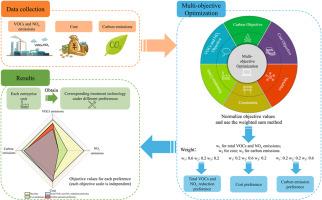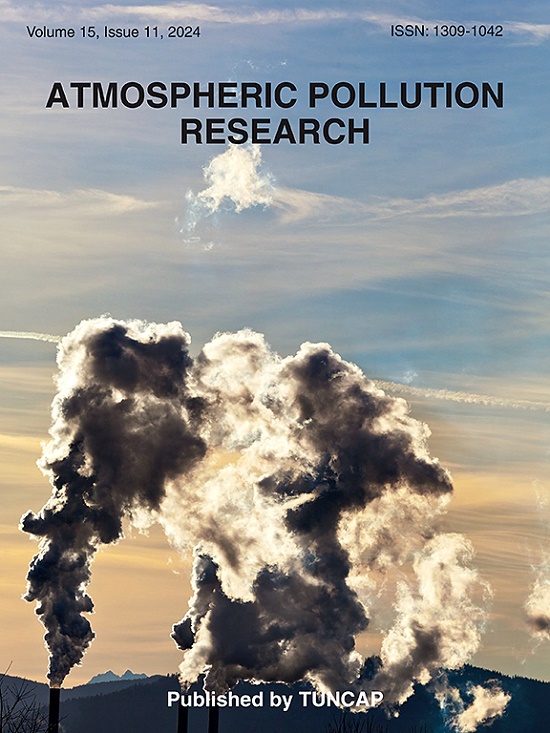Multi-objective optimization of VOCs and NOx co-reduction strategies under carbon emission constraints: A petrochemical case study in China
IF 3.5
3区 环境科学与生态学
Q2 ENVIRONMENTAL SCIENCES
引用次数: 0
Abstract
As a key contributor to atmospheric pollution, the petrochemical industry emits substantial quantities of volatile organic compounds (VOCs), nitrogen oxides (NOx), and carbon dioxide (CO2) emissions. This study develops a novel multi-objective optimization model for a local petrochemical facility (based on 2022 operational data), simultaneously addressing VOCs and NOx emissions, carbon intensity, and economic expenditures. By quantifying the cost-carbon nexus,it enables policy-relevant, priority-specific reduction pathways. Employing the weighted sum method under carbon emission constraints, this approach achieves >10 % reduction in individual emission (VOCs and NOx), with an overall emission decrease exceeding 30 % compared to baseline levels. Through the multi-objective optimization, we determine technologically optimal portfolios corresponding to three strategic scenarios: multi-pollutant control prioritization (VOCs-NOx co-reduction), cost-minimization orientation, and carbon-constrained operation. The optimized results demonstrate: (i) Annual emissions are minimized at 2,112.94 tons, representing a 66.52 % reduction versus baseline; (ii) Total costs are reduced to 1.549 billion CNY (16.45 % decrease compared to reference levels); (iii) Carbon emissions achieve a 9.83 % reduction, reaching 653,200 tons annually. Key sector-specific reduction potentials are quantified as: 9.99 % from VOCs emissions in circulating water systems, 4.53 % from equipment sealing point VOCs, and 88.9 % of total NOx treatment attributable to organized emission sources. These findings demonstrate that the proposed model offers considerable practical value in supporting the development of coordinated VOCs and NOx treatment strategies for carbon-regulated industrial facilities.

碳排放约束下VOCs和NOx协同减排策略的多目标优化——以中国石化为例
作为大气污染的主要贡献者,石化行业排放大量的挥发性有机化合物(VOCs),氮氧化物(NOx)和二氧化碳(CO2)排放。本研究为当地石化设施(基于2022年运营数据)开发了一种新的多目标优化模型,同时解决了VOCs和NOx排放、碳强度和经济支出问题。通过量化成本与碳之间的关系,它可以实现与政策相关的、特定于优先事项的减排途径。采用碳排放约束下的加权和法,该方法实现了个体排放量(VOCs和NOx)减少10%,总体排放量与基线水平相比减少超过30%。通过多目标优化,我们确定了对应于三种战略方案的技术最佳组合:多污染物控制优先(VOCs-NOx共同减少)、成本最小化导向和碳约束运行。优化结果表明:(1)年排放量减少至2,112.94吨,比基线减少66.52%;(二)总成本降至15.49亿元,较参考水平下降16.45%;(三)碳排放年均减少9.83%,达到65.32万吨。具体的关键部门减排潜力量化为:循环水系统中挥发性有机化合物的排放量占9.99%,设备密封点挥发性有机化合物的排放量占4.53%,有组织的排放源占总氮氧化物处理的88.9%。这些发现表明,所提出的模型在支持为碳管制工业设施制定协调的VOCs和NOx处理策略方面具有相当大的实用价值。
本文章由计算机程序翻译,如有差异,请以英文原文为准。
求助全文
约1分钟内获得全文
求助全文
来源期刊

Atmospheric Pollution Research
ENVIRONMENTAL SCIENCES-
CiteScore
8.30
自引率
6.70%
发文量
256
审稿时长
36 days
期刊介绍:
Atmospheric Pollution Research (APR) is an international journal designed for the publication of articles on air pollution. Papers should present novel experimental results, theory and modeling of air pollution on local, regional, or global scales. Areas covered are research on inorganic, organic, and persistent organic air pollutants, air quality monitoring, air quality management, atmospheric dispersion and transport, air-surface (soil, water, and vegetation) exchange of pollutants, dry and wet deposition, indoor air quality, exposure assessment, health effects, satellite measurements, natural emissions, atmospheric chemistry, greenhouse gases, and effects on climate change.
 求助内容:
求助内容: 应助结果提醒方式:
应助结果提醒方式:


